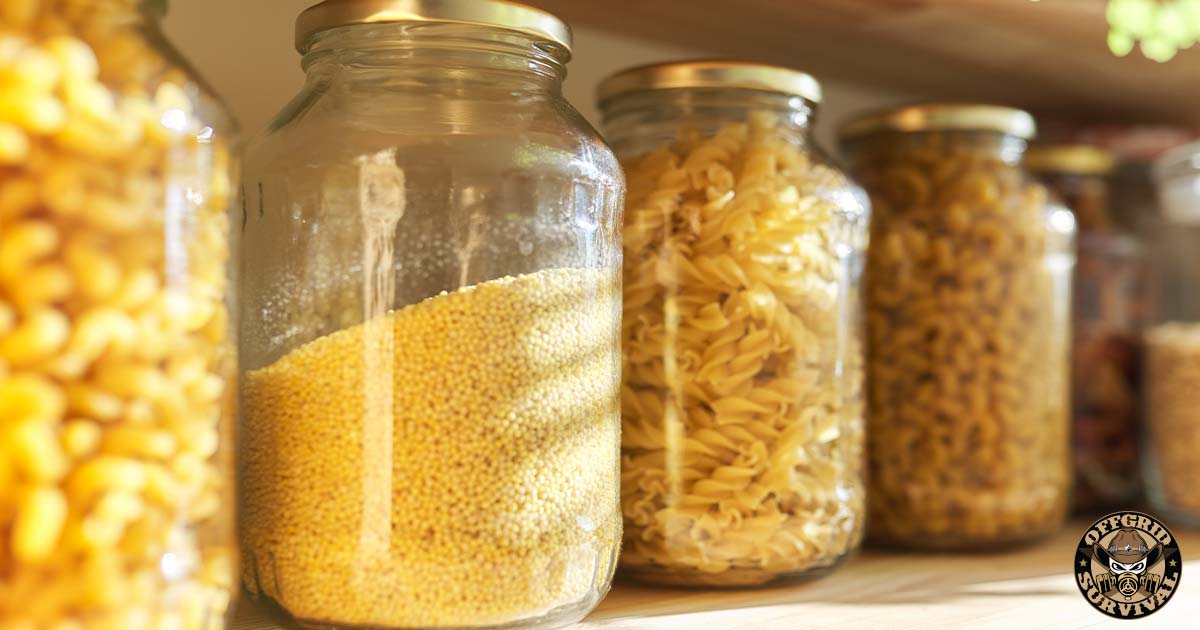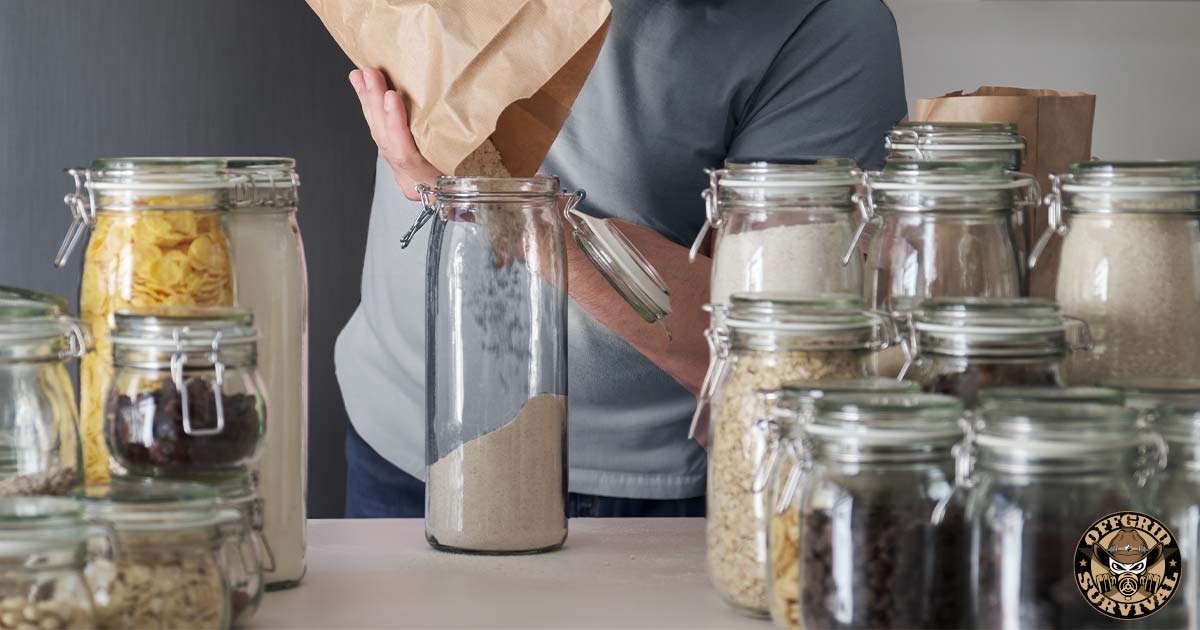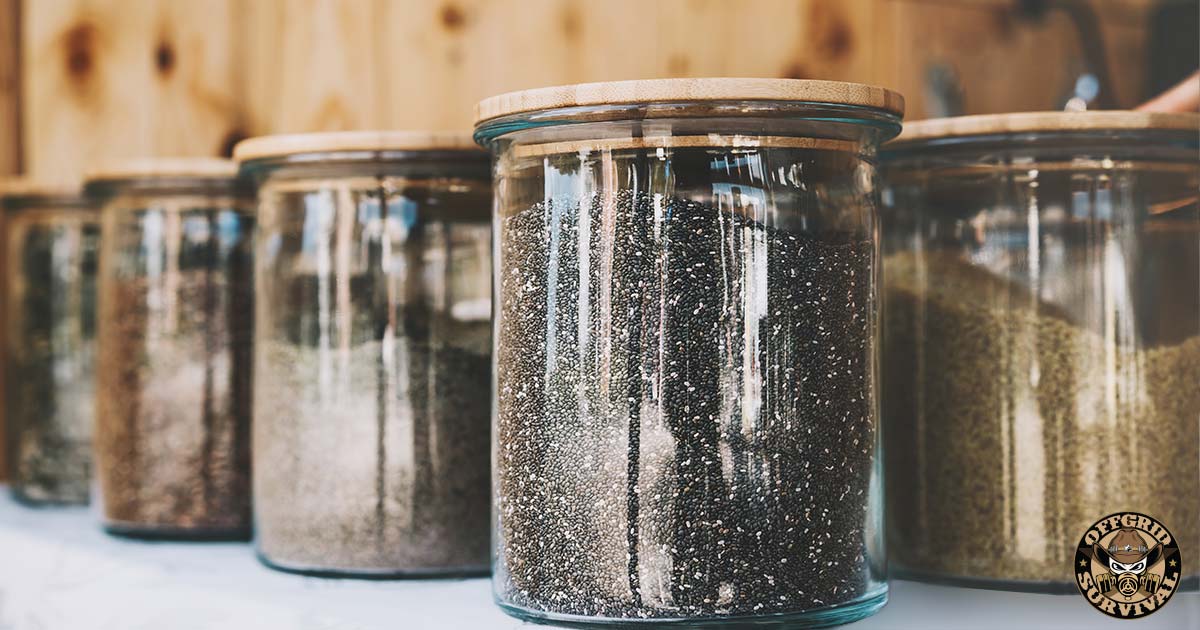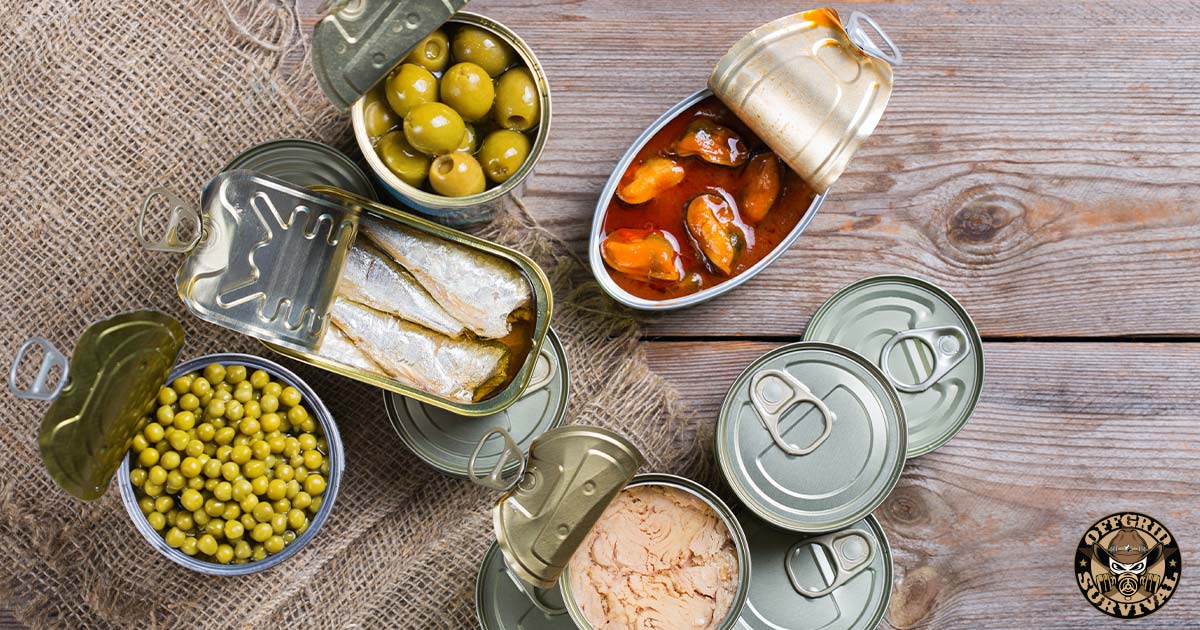
When disaster strikes, there’s a pretty good chance your local grocery stores will be stripped bare in a matter of hours. From panicked people trying to stock up on last-minute supplies to those who failed to prepare for even short-term disasters and now find themselves facing the prospect of starving, your local grocery store will look like a battleground in a post-apocalyptic movie.
Most grocery stores have a maximum three-day supply of goods on hand before they run dry. That means even short-term disasters like hurricanes, floods, and earthquakes can cause supply chain problems that will quickly wipe out their inventory. Now throw in a long-term disaster that cuts off supplies for months, and you have a real recipe for disaster.
To be prepared to face an emergency situation where supply chains fail and food deliveries are blocked, you need to invest in a long-term food supply. This supply should be made up of at least six months’ worth of emergency food with a long shelf-life – preferably something that you already eat.
From Supermarket Shelves to Survival Pantry: Building Your Emergency Food Stockpile with Long-Lasting Food From The Grocery Store

In the face of so many uncertainties, it’s important to ensure you and your loved ones’ survival by stocking an emergency pantry with long-lasting food supplies. While many so-called survival experts try selling commercial ‘survival food’ as the answer, we advocate for building your stockpile with familiar foods you probably already eat – all from your local grocery store or farmer’s markets.
During an emergency situation, the last thing you want to do is eat a bunch of weird survival foods that you’ve never eaten before – from possible allergy concerns to the stuff just downright tasting like crap, now is not the time to start experimenting. On top of that, we don’t like wasting money, so buying foods you already eat and running them on a rotation system that ensures you don’t find yourself years from now with a pantry full of expired food!
With the help of suggestions that have come in from our readers, we have compiled a list of the top food items and emergency supplies that you can buy at the grocery store. The list contains foods with a long shelf-life, items that have multiple uses, and supplies that are great for bartering.
Survival Foods that add flavor & comfort:
Comfort foods can be a huge morale booster during a stressful survival situation, something that needs to be kept in mind when starting to stockpile food. These four things can be stored for over 10 years, and are a great way to add a little bit of flavor to your cooking. If stored properly they will probably last indefinitely.
- Salt: From food preservation to maintaining proper electrolyte balance in the body to enhancing the flavor of your food, salt is an an essential part of your food storage stockpile!
- Sugar: – Brown or White sugars can be stored for quite some time and during emergencies or high-stress situations can help boost energy levels and provide a quick source of fuel. It can also be a huge morale booster when things start getting tough.
- Raw Honey: Honey has an incredibly long shelf life contains numerous vitamins, minerals, and antioxidants. Honey has also been used for centuries as a natural remedy for wound healing due to its antimicrobial properties.
- Alcohol – Whiskey, Vodka, etc.: From bartering to health and medicinal uses, alcohol is one of those items that should be part of any good preparedness stockpile. Check out our article on which liquors are best to stockpile for preparedness.
Base cooking ingredients with a long shelf life

Many people today lack the ability to cook anything from scratch, relying heavily on prepackaged and processed foods. This trend is unhealthy, but it could prove deadly during a long-term survival situation. Learning how to cook from basic ingredients is crucial for successfully preparing for emergencies and ensuring self-sufficiency in food storage.
The following categories of food make up the foundation of most recipes and are all things that store well.
Hard Grains: Stored properly hard grains have a shelf life of around 10 – 12 years.
- Buckwheat
- Dry Corn
- Kamut
- Hard Red Wheat
- Soft White Wheat
- Millet
- Durum wheat
- Spelt
Soft grains: These soft grains will last around 8 years at 70 degrees, sealed without oxygen.
- Barley,
- Oat Groats,
- Quinoa
- Rye
Beans: Sealed and kept away from oxygen the following beans can last for around 8 – 10 years.
- Pinto Beans
- Kidney Beans
- Lentils
- Lima Beans
- Adzuki Beans
- Garbanzo Beans
- Mung Beans
- Black Turtle Beans
- Blackeye Beans
Flours and Mixes and Pastas: 5 – 8 years
- All Purpose Flour
- White Flour
- Whole Wheat Flour
- Cornmeal
- Pasta
- White Rice ( up to 10 years)
Oils: It’s important to include fats in your stockpile. Fats are a concentrated source of energy and are crucial for overall health and well-being.
- Coconut oil – Unrefined, virgin coconut oil has one of the longest shelf lives of any kind of oil. It can last for over 2 years, has numerous health benefits, and is a great item to add to your survival food supply list.
- Clarified butter (Ghee): Clarified butter, also known as ghee, is butter that has been heated to remove moisture and milk solids. The process increases the fats stability and extends its shelf life. Ghee can last for several months to a year when stored in an airtight container in a cool, dark place.
- Olive oil: Extra virgin olive oil has a decent shelf life and can be stored for up to a year or more if kept in a cool, dark location.
For more information on cooking from scratch, check out these articles and books:
- Important Homesteading Preparedness Skills: Learn how to cook from scratch
- Best War Time Recipes: A Look at Preparedness Cooking Skills from the Past
- Fanny Farmer Cookbook
- Better Homes and Gardens Cookbook
- The Pioneer Woman’s Cookbooks
What About Buying Canned Goods for your Survival Pantry?
Proper Storage and Shelf Life of Canned Goods
We get a lot of questions on canned goods and how long they can safely be stored. To ensure the quality and safety of canned goods, it’s important to store them correctly and be aware of how long the manufacturer recommends they be stored. And remember, most best-by dates are placed there to protect the manufacturer from lawsuits, The U.S. Department of Agriculture says that most shelf-stable foods are safe indefinitely. In fact, they say canned goods will last for years and that dating is for quality, not safety.
Here are some guidelines to follow when dealing with store-bought canned goods and most shelf-stable foods:
1. Storage: Keep commercially canned foods and other shelf-stable products in a cool, dry location. Avoid placing them above the stove, under the sink, or in areas prone to high humidity or temperature fluctuations, such as a damp garage or basement.
2. Shelf life: The shelf life of canned goods varies depending on the type of food. High-acid foods like tomatoes and fruits maintain their best quality for up to 18 months, while low-acid foods such as meat and vegetables can maintain their original quality for 2 to 5 years. But again, if cans are undamaged (no dents, swelling, or rust) and have been stored properly in a cool, clean, dry environment, they can remain safe indefinitely.
3. Safety precautions: While extremely rare, the production of toxins by Clostridium botulinum bacteria poses the most significant risk when dealing with canned goods. To minimize the risk, make sure your cans are in good condition and show no signs of damage or contamination. If any cans appear compromised (bulges or leaks), it’s best to get rid of them to avoid any potential health hazards.
For more information on canning your own foods at home, check out our article on Canning your own food!
Survival Foods that are great during short-term disasters

The following items are great for short-term emergencies, and will stay fresh for a long period of time. During most disasters, you’re going to want to have food that requires very little cooking, or can be eaten without any preparation at all. Make sure some of your stockpile includes these types of food.
Other good survival foods: 2 – 5 years of shelf life
- Canned Fish: Tuna, Salmon, Sardines
- Canned Meats: Chicken, Beef, Pork, Spam & Sausages
- Canned Vegetables & Fruits
- Peanut Butter
- Coffee
- Tea
- Ramen Noodles – not the greatest food in the world but they are very cheap so they made the survival food list.
- Hard Candy
- Powdered milk
- Dried herbs and spices
- Canned soups (a variety of flavors)
- Canned pasta sauces
- Canned broth or stock (chicken, beef, or vegetable)
- Crackers or rice cakes
- Dried fruits (raisins, apricots, cranberries)
- Nuts (almonds, walnuts, peanuts)
- Granola bars or energy bars
- Cereal or granola
Items that can be used for more than cooking:
- Apple Cider Vinegar – Cleaning, cooking and has antibiotic properties
- Baking Soda – Cleaning, cooking, etc…
- Honey – Mentioned again for its antibiotic properties and wound healing.
Nonfood items to stock up on at the grocery store:
- Bic Lighters
- Toilet Paper
- Soaps
- Bottled Water
- Multi-vitamins or supplements
- Medicines
- Bandages
- Peroxide
- Lighter fluid
- Canning Supplies
- Charcoal
More Emergency Food Resources
While we always advise the DIY approach to stockpiling food, this way you have the things that you would normally cook and eat and can then rotate them in and out of your normal life, there are some circumstances where commercially made survival food supplies might make sense. Here are some of the top emergency survival foods that can help you quickly bulk up your emergency supplies.




What would you recommend for a milk back-up? We’ve tried 2 brands of powdered milk & 2 brands of evaporated milk. We followed the directions for rehydrating & for best taste, but they’re awful. Me and my husband don’t care as we just add them when baking/cooking but our 1 y/o won’t drink them.
I’ve tried the following; adding a bit of sugar and butter, adding some coffee creamer powder as well. Adding a drop or two of oil/butter to Ramen, soups, etc enhances taste because it carries a lot of the food’s flavors to the tongue, which are there but hidden. By the way, has anyone tried reconstituting butter powder with coconut oil?
I realised that by accident when eating a mug of Ramen and canned tuna with the same spork, wondering why the ramen all of a sudden had flavors to it!
First, I live about 40 miles from Ferguson, MO. so I appreciate it when martial law is put in place. I do want to stay alive and keep the bad guys confined at least to Ferguson. Otherwise I live in a rural area and began prepping seriously about 3 months ago. I’m a female retired deputy and have guns. Yes, I’ve always liked guns and appreciate their value. I’ve secured a food supply for maybe 2-3 months and our well is in our basement. Water not too much of a problem. However, collecting all the non-food items does take a list. Also putting together a good ‘first aid kit’ takes thought.Don’t put off thinking about all the non-food items you will need. I have put my inventory on my computer so it is easy to add items. You might think about these catagories to start. 11. Light & Heat, 222. Housewares, 3.Water 4. Disposable house wares 5. House cleaning & hygene 6.Sleeping & Towels, rags 7. Misc. like fishing gear, veg seeds, crayolas, coloring books (bordom)puzzles, books. 8. Food 9. Condiments 10. Soup 11.Dried beans, rice , couscous 12. Pasta, sauce 13. Meat, canned, dried (jerky) 14. Juice, beverages 15.Fruit 16. Vegetables 17. Misc. food snacks ie peanut butter, jelly, crackers………so, a lot to think about, more than you probably originally thought. Yes, if you plan to “bug in” rather than “bug out”, there is alot already in your house you can collect. Collecting it and putting all your prep in 1 area is a big job. So I started by reading all the suggested “lists’ other preppers offered to us. Used some of them, made my own shopping lists. Shopped The Dollar Tree (the best local dollar store) because there everything really is a dollar. Shopped Sam’s Club, then local Shop n Save. Hit junk and antique stores (found an old kerosene floor heater) and WalMart has the best price for a liter of kerosene (lamp or heater oil)$6.00+ per liter. So, start collecting, ie prepping.
Please be careful about stocking up on and eating canned tuna fish. It is no longer recommended since it contains high levels of mercury. Eating it occasionally, say once a month or so, shouldn’t be too dangerous, but more often than that could be – especially for children and pregnant women.
As you know the earth has suffered several natural disasters over the last years,
to improve your chances of survival, and protect your family against these events. You have to be prepared a survival supply list .By providing a survival list with some basic supplies you can yourself and your family will have a better chance to survive on your own after a catastrophic event.
Here is my top preppers supply list
Stock up on lots of good quality vitamin C (non-GMO and not made in China), Oil of oregano is a great antibiotic and a carrier oil to calm the burn from the oregano oil. Olive oil or coconut oil make good carrier oils, other essential oils for illnesses, zinc tablets, food grade activated charcoal. If you are not aware of the many wonder things charcoal can do you need to check it out. It healed my brown recluse spider bite, didn’t need a doctor. And from what I have heard charcoal is good for radiation poisoning. How about a sewing kit? Rolls of duct tape and rolls of plastic are always good items to have around. Get a colloidal silver generator, you could make up batches of this to barter.
Currently I have city water and I’m hoping someone can recommend a good method for getting drinking water. I’d like to collect rain for drinking but I don’t trust rain because of what is being sprayed in the atmosphere. I can’t afford to have a well drilled. Any suggestions?
I am 54 and would love to be able to talk to my mother and my grandparents about how they done things during the depression and how they handled hard times, but i don’t have that luxury, My older family have all pasted
Can you tell me where to find out how I could manage to save bees if everything goes awry. Is it possible indoors? Etc…
Depends on what you mean by indoors. Honey bees have been know to build nests in attics. They live in large groups so they can keep warm when it’s cold and cool when it’s hot, so yes. I actually have a certified (by the Wildlife Federation) wildlife habitat with the focus of saving the wild bees. Ten years ago when I moved here, I could only identify two bumble bees (I can tell them apart). Now there are hundreds of wild bees and the Great Black wasps (also pollinators). Where I live it gets to 45 degrees below zero, so you can see they do well on their own. 70% of all the 20,000 species of wild bees nest under ground. You can tell bumble bee nests by paying attention to the ground, if you see grass pressed down in circles, those are nest. The issue is providing them plenty of food during the warmer season so they can store for later. I don’t do lawn, those are useless for bees and other beneficial insects. They just need lots of native flowering plants and trees. Most of the pollinating is done by the wild bees, not the honey bees, which are native to Europe.
Don’t forget your Bible. It tells you how to survive anything!
I would definitely add non-scented chlorine bleach to this list. It can be used to purify water and as a disinfectant. To disinfect 1 quart of clear water, add 2 drops of bleach and wait 30 minutes.
Don’t forget vinegar! You can cook and clean with it, wash laundry, cure colds, etc!
White vinegar can be used to cook, preserve, clean and as medicine. Add that too! Also, some of the foods you mentioned are short term foods that should be used and rotated regularly. Long term dried, dehydrated, and freeze dried foods are best to store in massive quantities. You should rotate food and water every 3-5 years too. Only keep one years supply on hand though. Any more and it will be overkill on space, time and budget. Keep in mind that water can also go bad!!
I read with interest the listed items, including flours and mixes. I’ve seen a few sites where the long term storage of processed flours such as plain and self raising were not recommended. The reason they gave was that they wouldn’t store as well as whole grains and would quickly become rancid. Has anyone gained experience of trying to store these items and then see what their like after 2 to 5 years?
I’m amazed no one has mentioned a hand operated can opener. You have 3 canned items on the list. You make a point of not getting pop ups but don’t mention a HAND operated can opener. I was amazed before the 2000 freak out that most lists did not mention one.
As far a your list goes it seems to be a good list. As far as the debate on age goes, age is subjective just ask any school age child how old is old. The whole point is to prepare to survive.
Hi
South Africa is turning into a battle ground. Farm murders are increasing all time. The “white”race is facing the worst time of their lives ever! And nobody listens to our cry for help. The garbage our politicians feed the world is believed though, serious? Mr Trump signed in the Genocide Act recently. We qualify for assistance based on the basics contained in that Act. Please spread this far and wide.
Oooooooof
Little late for that CORONA VIRUS
It is actually great writing to learn. I was quite surprised by the information in this writing. I am a provider of products made of Himalayan salt. If you like Himalayan salt products then you can buy them from our site.
I’m the Kunta Commander and I know everything will be all right if we listen to Biden and the news. They will be our true saviors. Make sure you get your covid vaccine so you can stay alive. Maybe we’ll get lucky and have an annuel vaccine program so we can fight this virus. ***I’m not serious about any of this***
I meant to say “annual”.
Himalayan salt is 100 natural and beneficial for your health.